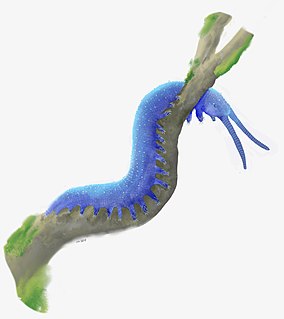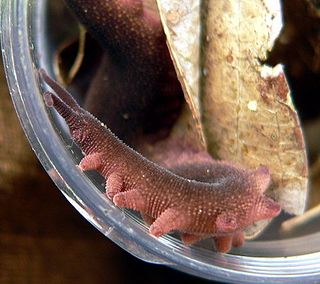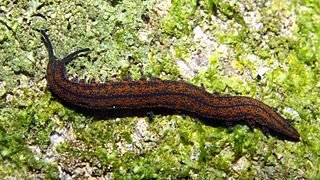 W
WCretoperipatus burmiticus is an extinct species of velvet worm that is known from Cretaceous Burmese amber approximately 100 million years old. It was found in Kachin state, Myanmar.
 W
WEoperipatus is a Southeast Asian genus of velvet worm in the family Peripatidae.
 W
WEuonychophora is an order of Onychophora representing all living onychophorans; the Peripatidae and Peripatopsidae. Their feet possess a pair of claws and a pad, and are covered with pustules. All remaining onychophorans are fossil species in the order Ontonychophora.
 W
WEuperipatoides is a genus of velvet worms in the family Peripatopsidae. All species are found in New South Wales, Australia. E. rowelli is also found in the Australian Capital Territory.
 W
WEuperipatoides kanangrensis is a species of velvet worm of the Peripatopsidae family, described in 1996 from specimens collected in Kanangra-Boyd National Park, New South Wales. It is endemic to Australia. The embryonic development of Euperipatoides kanangrensis has been described. This species is used as model organism for the last common ancestor of the Panarthropoda. It resembles fossil Cambrian lobopodians.
 W
WOoperipatellus nanus is a species of velvet worm in the Peripatopsidae family. This species is endemic to New Zealand and is found in the South Island.
 W
WOroperipatus is a genus of Neotropical velvet worms in the family Peripatidae.
 W
WPeripatidae is a family of velvet worms. The oldest putative representatives of the family herald from Burmese amber dated to the mid-Cretaceous, around 100 Ma, with representatives from Dominican and Baltic amber attesting to a broader distribution in the Palaeogene / Neogene; molecular variability suggests that the family's crown group may have arisen in the early Mesozoic.
 W
WPeripatoides is a genus of velvet worms in the Peripatopsidae family. These animals are nocturnal hunters that spit glue to trap their prey. In New Zealand species of Peripatoides have 14, 15 or 16 pairs of legs. Female Peripatoides produce eggs that are fertilized internally and babies develop inside their mother until large enough to be born, in batches of 4-6, as colourless miniatures of the parents.
 W
WPeripatopsidae is one of the two living velvet worm families.
 W
WPeripatopsis is a genus of South African velvet worms in the Peripatopsidae family.
 W
WPeripatopsis capensis is a species of velvet worm in the Peripatopsidae family. The type locality is in South Africa.
 W
WPeripatus juliformis is a species of velvet worm in the Peripatidae family. The type locality is in Saint Vincent Island. This species became the first velvet worm known to science when Guilding described it in 1826.
 W
WTasmanipatus is a genus of velvet worms in the Peripatopsidae family. They are endemic to Tasmania, Australia.
 W
WThe blind velvet worm is a species of velvet worm in the family Peripatopsidae. The species is listed as Endangered on the IUCN Red List.